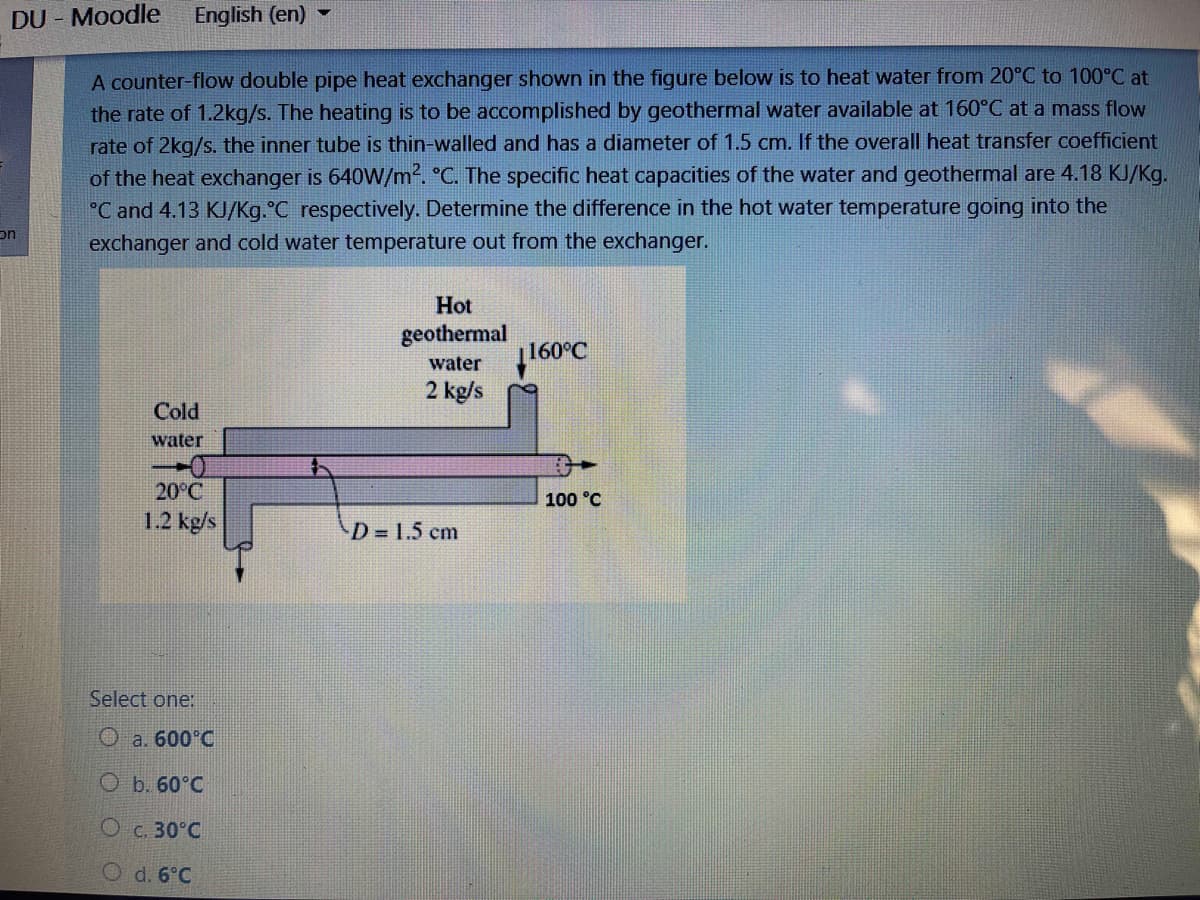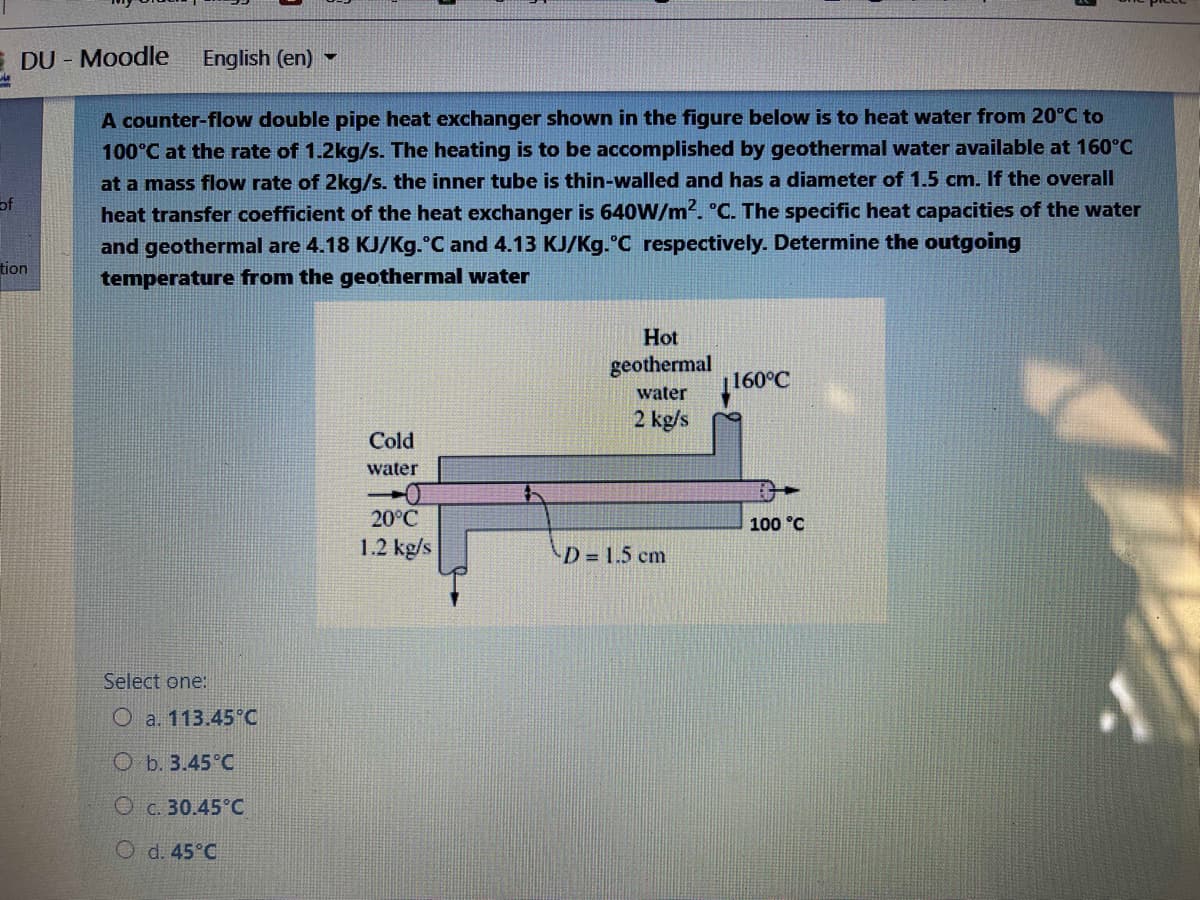A counter-flow double pipe heat exchanger shown in the figure below is to heat water from 20°C to 100°C at the rate of 1.2kg/s. The heating is to be accomplished by geothermal water available at 160°C at a mass flow rate of 2kg/s. the inner tube is thin-walled and has a diameter of 1.5 cm. If the overall heat transfer coefficient of the heat exchanger is 640W/m2. °C. The specific heat capacities of the water and geothermal are 4.18 KJ/Kc °C and 4.13 KJ/Kg.°C respectively. Determine the difference in the hot water temperature going into the exchanger and cold water temperature out from the exchanger. Hot geothermal 160°C water 2 kg/s Cold water 20°C 100 °C 1.2 kg/s D 1.5 cm Select one: O a. 600°C O b. 60°C O c. 30°C O d. 6°C
A counter-flow double pipe heat exchanger shown in the figure below is to heat water from 20°C to 100°C at the rate of 1.2kg/s. The heating is to be accomplished by geothermal water available at 160°C at a mass flow rate of 2kg/s. the inner tube is thin-walled and has a diameter of 1.5 cm. If the overall heat transfer coefficient of the heat exchanger is 640W/m2. °C. The specific heat capacities of the water and geothermal are 4.18 KJ/Kc °C and 4.13 KJ/Kg.°C respectively. Determine the difference in the hot water temperature going into the exchanger and cold water temperature out from the exchanger. Hot geothermal 160°C water 2 kg/s Cold water 20°C 100 °C 1.2 kg/s D 1.5 cm Select one: O a. 600°C O b. 60°C O c. 30°C O d. 6°C
Principles of Heat Transfer (Activate Learning with these NEW titles from Engineering!)
8th Edition
ISBN:9781305387102
Author:Kreith, Frank; Manglik, Raj M.
Publisher:Kreith, Frank; Manglik, Raj M.
Chapter10: Heat Exchangers
Section: Chapter Questions
Problem 10.32P
Related questions
Concept explainers
Heat Exchangers
Heat exchangers are the types of equipment that are primarily employed to transfer the thermal energy from one fluid to another, provided that one of the fluids should be at a higher thermal energy content than the other fluid.
Heat Exchanger
The heat exchanger is a combination of two words ''Heat'' and ''Exchanger''. It is a mechanical device that is used to exchange heat energy between two fluids.
Question

Transcribed Image Text:DU - Moodle
English (en)
A counter-flow double pipe heat exchanger shown in the figure below is to heat water from 20°C to 100°C at
the rate of 1.2kg/s. The heating is to be accomplished by geothermal water available at 160°C at a mass flow
rate of 2kg/s. the inner tube is thin-walled and has a diameter of 1.5 cm. If the overall heat transfer coefficient
of the heat exchanger is 640W/m. °C. The specific heat capacities of the water and geothermal are 4.18 KJ/Kg.
°C and 4.13 KJ/Kg.°C respectively. Determine the difference in the hot water temperature going into the
on
exchanger and cold water temperature out from the exchanger.
Hot
geothermal
|160°C
water
2 kg/s
Cold
water
20°C
100 °C
1.2 kg/s
D 1.5 cm
Select one:
O a. 600°C
O b. 60°C
O c. 30°C
O d. 6°C

Transcribed Image Text:E DU - Moodle
English (en) -
A counter-flow double pipe heat exchanger shown in the figure below is to heat water from 20°C to
100°C at the rate of 1.2kg/s. The heating is to be accomplished by geothermal water available at 160°C
at a mass flow rate of 2kg/s. the inner tube is thin-walled and has a diameter of 1.5 cm. If the overall
of
heat transfer coefficient of the heat exchanger is 640W/m?. °C. The specific heat capacities of the water
and geothermal are 4.18 KJ/Kg.°C and 4.13 KJ/Kg.°C respectively. Determine the outgoing
tion
temperature from the geothermal water
Hot
geothermal
|160°C
water
2 kg/s
Cold
water
20°C
100 °C
1.2 kg/s
D= 1.5 cm
Select one:
O a. 113.45 C
O b. 3.45°C
O c. 30.45°C
O d. 45°C
Expert Solution
This question has been solved!
Explore an expertly crafted, step-by-step solution for a thorough understanding of key concepts.
Step by step
Solved in 3 steps with 1 images

Knowledge Booster
Learn more about
Need a deep-dive on the concept behind this application? Look no further. Learn more about this topic, mechanical-engineering and related others by exploring similar questions and additional content below.Recommended textbooks for you

Principles of Heat Transfer (Activate Learning wi…
Mechanical Engineering
ISBN:
9781305387102
Author:
Kreith, Frank; Manglik, Raj M.
Publisher:
Cengage Learning

Principles of Heat Transfer (Activate Learning wi…
Mechanical Engineering
ISBN:
9781305387102
Author:
Kreith, Frank; Manglik, Raj M.
Publisher:
Cengage Learning